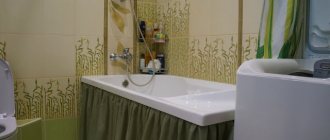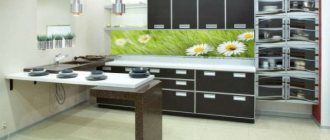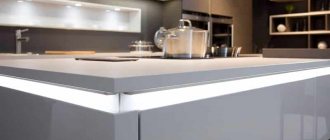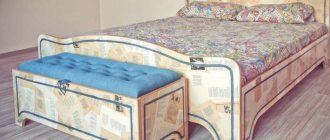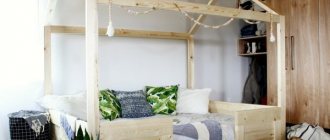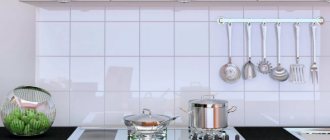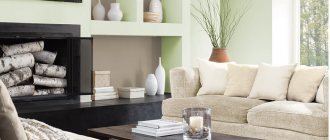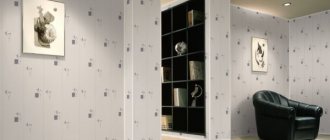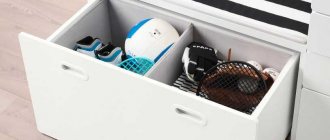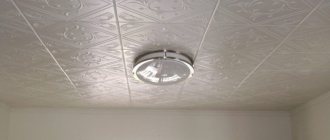Furniture plastic HPL is a polymer material that is most often used for finishing kitchen facades and countertops. Thanks to the application of HPL coatings, kitchen units acquire an original and beautiful appearance, and also become more resistant to wear and high humidity.
At the same time, the technology for decorating furniture with HPL plastic (veneering) has its own specifics. How to properly glue furniture plastic will be discussed below.
Plastic for the kitchen
Gradually, new, interesting materials come into our lives.
Once upon a time tiles, concrete, and decorative stone were used; today many people prefer MDF, chipboard and plastics. The latter began to be actively used in construction, in everyday life, and in the creation of furniture for bathrooms, living rooms, bedrooms, hallways, kitchens, which is quite justified. Decorative plastic for furniture meets the highest quality requirements. The decorative layer of this paper-laminated material can have either a glossy or matte surface, or a surface combined in the form of a pattern, for example, flowers, and can be made in various colors: from popular monochrome, “wood” and “stone” to fancy decors like silver or gold with a pearlescent or metallic sheen. Modern decorative plastic for furniture produced by LEMARK opens up wide opportunities for the implementation of design ideas. Today you can buy laminated plastic of different textures, having either ornate patterns in the form of flowers, ornaments, or with a perfectly smooth or corrugated surface that imitates natural wood of various species, granite and slate, or a smooth, high-gloss surface.
Among the variety of products made from DBSP, a special place is occupied by kitchen facades and countertops with plastic HPL coating. Thanks to the hygiene of DBSP, ease of care, and high performance characteristics, such furniture will last for many years. It is no coincidence that facades, countertops, shelves and wall aprons with decorative laminated paper plastic HPL can be found in kitchens in the middle, high and even premium price segments. It's all about its thickness and protective layer. The greater the thickness of the facing plastic, the higher its impact strength and the better quality of products obtained from it. However, the thicker and better the protective layer, the more expensive it is. That is why, for example, in kitchens in the low price segment, as a rule, matte CPL plastics with a thickness of 0.4 or 0.5 mm and without a protective layer are used on countertops. In kitchens of the middle price segment, the thickness of the plastic is already 0.6-0.7 mm; as a rule, there is a special protective layer, a glossy finish (only HPL DBSP can have such a finish), and various embossings that imitate natural materials. In kitchens of the high price and premium segments, only high-pressure decorative plastic (HPL DBSP) or, as it is often called, HPL laminate, with a thickness of 1 mm to 25 mm with a special protective layer, is used. At the same time, the dark brown strip visible on the cut of laminated plastic is its business card, by which one can determine the thickness and can easily be distinguished from cheaper analogues, such as various NON-LAMIED plastics such as: PVC films, single-layer melamine films and films with a finish. effect or laminated chipboard (chipboard). Thanks to the presence of a wide variety of decors and embossing in the collection of laminated plastics LEMARK, furniture made with HPL Lemark will decorate kitchens of various styles, not only in high-tech style, but also in Provence, modern and even classic styles. Today you can buy plastic for furniture facades and tabletops, distinguished by both bright, saturated colors, which further emphasizes the futuristic design, and with patterns and embossing that completely imitate shabby, aged over the years, but so warm wood.
Glue for MDF panels - which one to choose and how to glue
MDF panels are attached to the wall in two ways - using lathing and glue. And if there is a lot of information about the first method, then they talk about the second extremely rarely. One of the most important aspects of the work when fastening with glue is the choice of adhesive composition, which ensures quick and reliable fixation of the slabs to the base.
Panel adhesive requirements
Manufacturers of construction chemicals offer customers a huge range of adhesive compositions, which differ not only in price and packaging volume, but also in basic characteristics.
It’s really difficult to make a choice with such variety.
MDF adhesive must meet the following criteria:
- Have a clearly defined purpose. The label must indicate “universal” or “designed for use with wood-based panels.”
- Provide strong and reliable fastening to a mineral (stone, brick, plaster) or organic (chipboard, OSB, DSP) type base.
- Have a high level of adhesion and set quickly. As a rule, manufacturers try to highlight this characteristic in the name with the words “strong”, “super strong”, “multi” and so on.
- Demonstrate resistance to moisture, chemicals (salt, acid, alkali), temperature and humidity changes.
We especially note that it is recommended to glue MDF panels to walls only in interior spaces, therefore frost-resistant additives are not introduced into the adhesive compositions.
Some buyers have another requirement for glue - transparency. Inexperienced craftsmen are afraid that drops of adhesive composition may appear at the joints and spoil the overall picture. However, this is an unnecessary precaution.
MDF panels have a standard tongue-and-groove connection system, convenient for installation using traditional lathing or glue.
And at the corners and along the perimeter, the joints are closed with decorative fittings made of MDF, PU or PVC (corners, plinths, cornices), so any defects will be hidden behind the overlays.
Let us add that transparent silicone-based compounds are produced mainly for plumbing work; they are water-resistant, economical in consumption and are intended mainly for stone, glass, ceramics, earthenware, acrylic and other similar materials. It is not recommended to glue panels made of particle boards and fibreboards with them.
Types of adhesives for mounting MDF boards
So, what types of adhesives provide the best fastening of panels to the wall? Conventionally, they can be divided into three groups:
- Universal compounds designed to work with heavy products made of stone, metal, glass, rubber, wood, polystyrene, etc. This category includes such well-known compounds as Titan (Titan Wild), Titebond (Multi Purpose), Moment (Moment-1), Tytan (Euro-Line No. 601) and others.
- Special assembly adhesives of the “Liquid Nails” series. In frameless construction, they are in greatest demand among both professionals and amateurs. One of the leaders on the Russian market is Moment Liquid Nails glue.
Additionally, a metal structure called a “gun” is purchased, which facilitates the use of glue. Let's name some popular compositions:- Moment (Moment-montage or Moment Crystal),
Titebond (Heavy Duty extra strong and Solvent Free extra strong without solvent),
- Makroflex (MF220 Heavy Duty),
- Liquid Nails “Liquid Nails” (LN-910 Panels and LN-901 Heavy Duty) and others.
- Polyurethane foam. Of course, the main purpose of this product is sealing, but professionals often use this compound to glue panels to the wall and even the ceiling. Each manufacturer has at least two types of this composition in its assortment: for interior work and universal. For our purposes, any will do.
Choosing foam today is no less simple than choosing glue
For less experienced craftsmen, the “Liquid Nails” composition is better suited for installing MDF panels on the wall. The glue is quite easy to use, the fastening is tear-resistant, applied in a thin or thick layer, thanks to which small surface defects can be smoothed out.
After drying, the mounting composition remains flexible and elastic, thereby ensuring resistance to deformation and vibration. This is especially important for boards made of particle board materials, since they tend to change linear dimensions with changes in temperature and environmental humidity.
Features of using glue for MDF panels
The most durable fastening is achieved on smooth, dry, grease-free surfaces. The universal or mounting compound is applied pointwise in large drops or in zigzag movements, after which you need to wait a while (the duration of the technological break is indicated on the label), attach the panel to the wall, press and tap over the entire surface with a fist or a rubber mallet.
Correct application of glue on MDF panel
For adjustment, the master has from 5 to 15 minutes, after which the composition polymerizes and hardens. Excess glue should be removed immediately with a damp cloth or alcohol, and after hardening it can be cut off with a sharp knife.
Panels can also be glued to the wall using construction foam. The technology gets a little more complicated. The base needs to be moistened with a spray bottle, a thin layer of mounting compound applied, the panel attached, pressed, then torn off and reattached. Tap the surface thoroughly and leave until completely hardened.
We warn you! Any construction adhesive is a toxic chemical multicomponent compound. It has a toxic odor and negatively affects health, so when working, ensure an intense flow of fresh air, constant ventilation, and even better, exhaust ventilation. As soon as signs of poisoning appear (dizziness, nausea, suffocation, etc.), you need to stop work, leave the room and take sorbents before the doctor arrives.
If the adhesive comes into contact with the skin, it may cause irritation, so the affected area should be washed with plenty of water and a mild detergent and treated with symptomatic treatments.
Source: https://drevplity.ru/mdf/vybor-i-osobennosti-kleya-dlya-mdf-panelej
Solupren X2
| Contact adhesive Aspruzzo X2 | |
| Brand | Solupren (Italy) |
| vendor code | Solupren X2 |
| Packaging, kg | 16 |
| Purpose |
|
| The basis |
| Polychloroprene |
| Properties |
|
The plastic was cut with a small allowance for further milling
The edge of the facade will be the same plastic; it must be cut into strips 19 mm wide, this is the standard size of edge materials.
The next step is to apply glue to the surfaces to be glued, to the base of the facade and the plastic, since in our case the plastic has a matte finish and a fairly decent thickness of 1 mm and deep embossing (relief or bump in the language of 3D graphics visualizers), the glue can be evenly applied using a roller with fine pile or apply by spraying.
Let the glue dry slightly, readiness can be checked by lightly touching it with the back of your hand (by the way, I don’t know what the back of the hand is called and I’m unlikely to ever find out), no particles of glue should stick to the skin. Or, as recommended, 10-15 minutes, without blowing, 5 minutes with blowing.
We carefully apply the plastic to the base material; it is advisable to carry out these operations together, since if the application is incorrect or inaccurate, further adjustments to the bonded surfaces will be impossible.
What to look for when choosing glue
In order for plastic panels to last a long time and have a presentable appearance, you should take the choice of adhesive seriously.
It is worth noting that in construction stores you can find adhesives that are intended specifically for installing PVC boards. However, a situation may arise when there is no such product or the owner of the premises has some preferences. Usually, those who are planning to do repairs themselves are puzzled of what kind of glue to use The choice of means for fastening is, of course, important, but we must not forget about other conditions.
The adhesive composition for PVC panels must have the following properties:
- After drying, it should be transparent so as not to spoil the appearance of the finish.
- The composition used must be well resistant to moisture, temperature changes, cold, and the like.
- It is important that the glue sets quickly.
- The quality of gluing should be as high as possible.
- It is also worth considering the durability of the fastening.
- The glue used must be safe for health, so you should avoid toxic compounds that have a strong odor.
It would be useful to have antibacterial additives in the glue . A correctly selected composition will ensure that the finishing material is well attached to the wall and the panels will decorate the room for many years, despite the aggressive effects of water and temperature changes.
Storage and conditioning
HPL plastic sheets must be stored in a horizontal position; the sheets are folded in pairs, one on one, with the decorative surface facing each other (placed on a flat, durable surface - racks). It is not recommended to place sheets vertically.
Storage at an angle of 60° to the surface using supports is allowed. The material must be stored in a covered, dry room (room temperature: 10-30°C; room humidity: 50-65%). Before starting the production of furniture facades, it is necessary to keep all blanks in the room in which the work will take place.
HPL plastic for kitchen facades and the base on which it will be glued must be at the same temperature. A damp sheet of material may crack and delaminate, and a damp sheet may swell if not enough glue is used. Therefore, it is very important to follow the recommendations for storing the material.
In exceptional cases, HPL plastic sheets can be dried quickly: the plastic, separated by boards, is placed in a heated room (for about 2 hours at room temperature 50°C or 3 hours at 40°C). You can also place two sheets of HPL plastic facing each other and place them in a hot press for a short period of time (10 minutes at 70°C). This type of drying must be done several hours before you start gluing it.
PVC mosaic
Mosaic masonry always looks impressive, but natural materials are quite expensive. You can also make a mosaic from PVC panels, and this is done easier than it seems at first glance. Installation is carried out both in the kitchen and in the bathroom. This is a worthy replacement for ceramics; PVC is also not afraid of moisture, is resistant to temperature changes and looks decent. Another important plus: mosaic decorates small irregularities and defects in the wall due to its plasticity.
- The panels can be installed directly on the wall.
- The surface must be clean.
- The sheets are cut with a construction knife.
- Each sheet is covered with glue.
- The part is pressed tightly against the wall until it fully adheres.
- Complete drying time is 2-3 days.
- When installing mosaic parts, joints will appear. They are treated with sealant.
Installation of PVC panels is a good solution for quick DIY renovation of premises. It is not enough to choose high-quality material; accompanying products can have a greater impact on the result. So, the stronger the glue, the longer the plastic panels will last.
Source: goodklei.ru
cutting
- Cutting tools are recommended to be used with carbide tips
- During the cutting process, the HPL plastic sheet should be placed on a clean and flat surface with the decorative side down
- Saw direction: from the side of the decorative layer (to prevent chipping)
- Cutting speed: 25-40 m/min
- The internal corners of the grooves must be rounded (to avoid chips and cracks)
- Diameter of steel saw for straight cutting: 25 – 45 cm
- Diameter of steel saw for curve cutting: 12 – 16 cm
- When cutting, it is most important to consider three factors: accurate guide, sufficient pressure on the HPL sheet at the cut site (use pressing tools), correct blade projection
- It is allowed to cut two sheets at the same time if maintaining the exact dimensions is not critical
- It is recommended to use blades thicker than 2mm (otherwise they may leave jagged edges on the material)
- For cutting complex formats, use a band saw and fine-tooth blades (such as those used for cutting light metals)
Sheet panels (PVC mosaic): instructions for gluing
In this article we will talk about sheet decorative PVC wall panels that imitate ceramic mosaics.
These are high-quality panels made using modern German technologies. For the production of such panels, PVC plastic is used, which is a strong, durable, moisture-resistant and non-flammable material. The thickness of the panels is 0.4 mm. The panels are used for interior decoration of premises, living rooms, loggias and balconies. To transform the interior, it is enough to paste over one wall or even a fragment.
Use of sheet panels
Panels in the interior
Sheet panels are easy to care for: resistant to moisture and easy to clean. They have a wide selection of shapes and colors, which helps transform any interior at minimal cost.
Necessary tools for gluing
• Sheet panels in the required quantity; • Scotch; • Knife, scissors; • Ruler, level; • Universal edging 1 m long, which is used to decorate the surface to be pasted; • Glue
Before starting work, it is necessary to clean the walls from dirt and dust, otherwise the sheet panels will not adhere well. In this case, it is not at all necessary to achieve a perfectly flat surface, since the sheet panels themselves will hide all the imperfections. It is necessary to glue the edging along the edge of the working surface. On a horizontal surface, the edging is glued using a level, and on a vertical surface - using a plumb line.
Edging and joining profile
When installing mosaics, the main requirement is even gluing. To do this, it is better to stretch the thread from the right to the left edge and secure it to the wall with tape.
Cutting panels to size
The glue must not be applied completely to the entire sheet, but only to its protruding parts. A minute after applying the glue, the sheets must be glued to the thread. To simplify the work, it is better to start pasting the wall from the top edge from the ceiling, while securing the sheets with masking tape to the wall. To match the pattern of the second row of sheets, you need to rotate them 180 and do all the steps with the thread again.
Applying glue to panels
Thus, it is not at all necessary to have special skills to work with sheet panels; the main thing is to adhere to the basic rules, by observing which you will be able to create a bright and modern design.
Source: rsk-nsk.ru
Drilling
- When drilling holes, place the HPL sheet on a solid base of chipboard or wood
- Recommended drills: sharp angle twist drills with wide drilling gap
- Recommended drill sharpening angle: 60° and 80°
- Drills for making holes up to 15 mm in diameter: screw
- Drills for making holes with a diameter of 15-40 mm: expanding
- To produce holes with a diameter of more than 40 mm, adjustable circular blades with a guide are used. The hole is drilled on both sides
- When drilling holes, the surface of the HPL plastic should not heat up
- A sheet of HPL plastic can slightly change its dimensions when exposed to temperature, so the holes for fasteners must be larger in diameter than the diameter of the screw or self-tapping screw
With reduced humidity, HPL plastic sheets dry out. When elevated, they increase.
- It is recommended to use rubber or plastic spacers (to avoid over-tightening the screws)
- Screws with oval heads must not be used. It is recommended to use self-tapping screws and screws with a horizontal stop head
Deciding on the material
It turns out that the polymer can be different, so from time to time all our attempts to glue a polymer product together do not lead to a suitable result.
It is impossible to find the type of polymer by eye or touch, so let’s inspect our product for the presence of markings that resemble a Mobius Loop on the outside with different meanings. You can see the types of polymer in the photo. Depending on the marking, you can now select glue for any product. But even in this case, when an advertisement invites you to purchase an all-purpose miracle glue, you should not count on effective gluing, maybe this is just a PR trick.
Having “recognized” the polymer material more closely, you need to select your own solvent for its type:
- Brand PA66 is glued using a solvent containing formic acid.
- The PMMA grade requires dichloroethane.
- ABS - acetone glue is suitable.
Gluing
HPL plastic can be glued to MDF, plywood boards, fiberboard, chipboard (the base material must also dry and reach the same temperature as HPL plastic before going into production). Recommended operating temperature: 18 – 22°C, air humidity – 50%. The glue is applied to the back side of the HPL plastic sheet. Strictly control the uniform application of glue and its quantity. The rougher the surface of the material, the greater the amount of glue required. During the gluing process, it is necessary to ensure uniform pressure.
After the gluing process, it is necessary to keep the furniture facades for 48 hours at room temperature 20 - 24°C and relative humidity 45 - 55%.
We work with plastic, which is widely used in furniture production
Plastic has become such a part of our lives that we sometimes wonder how we ever managed without it. It is used as a facing material. It is also indispensable in furniture production, since it is highly resistant to fats, food products, and chemicals.
If you stick plastic onto MDF and chipboard, you can solve many problems of housewives who cook in the kitchens. This also allows you to significantly transform future furniture.
High-quality gluing is provided by HolzMarkt specialists, who use modern materials and advanced technologies when performing this procedure.
Why HPL is the best plastic for the kitchen
- Kitchen plastic HPL is resistant to mechanical stress
- There are no pores on the surface of the HPL panel, therefore moisture is not absorbed
- Furniture facades made of plastic retain their aesthetic appearance for a long period of time
- Plastic facades are anti-allergenic
- Furniture plastic is easy to clean and resistant to chemicals
In the direction of M8 Furniture you can buy HPL plastic for kitchen facades made in Italy by Abet Laminati. The warehouse program includes more than 200 colors of plastic for facades.
At the moment, in the M8 Furniture direction there is a “Total Temptation” promotion and the price per sheet of HPL plastic starts from 11.82 euros per sheet (payment is made only in Belarusian rubles).
Product examples
There are several trusted manufacturers that produce special glue for plastic:
Moment crystal
- Universal adhesive for plastic Kleiberit on synthetic resins. Sold in tubes with a convenient nozzle. It has an affordable price, but it fixes PVC well, is not afraid of moisture and dries quickly. The composition is safe.
- Glue " Moment-crystal ". Also a universal adhesive, it can attach a plastic panel to almost any base. The advantage of the composition is that it is transparent.
- Another Moment glue is liquid nails (“ Installation ”). Lives up to its name. It will firmly connect even poorly compatible materials. There are samples for both interior and exterior work.
- " Emphikol " is a special composition for working with polyvinyl chloride. Colorless, viscous, forms a strong connection between the plastic and the surface.
- MitreFix is an alternative composition that is moisture resistant. Forms a strong seam.
MitreFix
The main thing in choosing an adhesive is the mark on the packaging that the composition is suitable for working with plastic. If you are not sure of the glue’s abilities, contact a specialist consultant and read the instructions. It is recommended to buy glue only in construction departments, so as not to receive a fake or low-quality product.
Useful tips
Quite often, household members forget one simple truth.
MDF film does not like elevated temperatures, and therefore you need to try to insulate the material from strong heat. Otherwise, peeling will occur constantly.
Therefore, here I can highlight several practical recommendations:
- Follow the operating instructions. If you have beautiful facades with integrated handles, or any other design options, keep them away from heat sources. This is an oven and direct sunlight. This can be implemented in different ways, from placement to blinds and curtains on the windows;
- Use an aluminum profile in places where there is a high risk of peeling off. Decide for yourself which one to choose and how to paint it if necessary. There are several types of profiles. They need to be installed on the edge, thereby preventing it from peeling off;
- Choose your kitchen furniture carefully and think through the layout in advance. This will allow you to deal with a high-quality kitchen, and avoid the typical problems of cheap and poorly executed designs.
Types of adhesives used for gluing chipboard products
Modern industry offers a more than extensive range of adhesives that can be used for the intended purpose. Among the most popular adhesive compositions are the following:
Epoxy adhesive based on formaldehyde resin is the best option for filling deep defects such as potholes. It ensures reliable contact of the parts being joined, but hardens very slowly, is extremely toxic, and therefore should not be used for gluing household items.
Contact adhesive based on synthetic rubber or butane styrene - suitable for the restoration of outdoor and indoor furniture made from chipboard
Animal glue is a granular glue that requires serious preliminary preparation, but satisfies all the basic requirements for furniture glue.
Hot-melt adhesive – is a melt applied from a glue gun, convenient for gluing chipboard furniture pieces.
Where should edging be done?
Furniture manufacturers often edge only the visible parts of the end surfaces. From the point of view of economy, this seems quite understandable, but taking into account the above facts, this approach can lead to certain problems - the protective edge must be present in all places where there is an open internal structure of the chipboard.
If you purchased furniture with unprotected edges, you can easily do their edging yourself at home. To do this, you do not need to have any special equipment - the edge can be glued with a regular iron.
Don’t be lazy to spend a few minutes on this operation - you will reliably protect yourself and your furniture and significantly extend its service life. Next, we will look in detail at how to properly glue the edge tape with your own hands.
Features of choosing a composition for upholstered furniture
When making upholstered furniture, the adhesive composition must be able to glue wooden planes with other materials (plastic, fabric, foam elements, leather).
Adhesive for upholstered furniture should provide durable, flexible, strong bonding. At the same time, have increased adhesion.
Furniture is often installed near the heating system, so the seams should not react to rising temperatures.
It is preferable that gluing is done with an environmentally friendly composition. Today it is a water-based representation.
Varieties
Several types of adhesives have been identified, differing in purpose. Each has a high drying strength. Varieties:
- Water-based - PVA, animal. Designed for fixing fabric bases of furniture, foam elements, non-woven fibers. When attaching such bases, other types are not suitable, as they can damage the surface (superglue can corrode the fabric.
- Carpentry (resorcinol). Made from aliphatic resins. Used for gluing wooden elements. Subsequently, the glued product can be used outdoors.
- Contact – rubber-based, thermal, PVA of special strength. Purpose: repair, restoration of furniture that is used indoors and outdoors. It sets quickly, but it dries completely within a day.
Several types are distinguished according to the principle of solidification:
- Quick drying. These include PVA; it is enough to leave the glued element in a ventilated area for rapid gluing to occur.
- Hot melt adhesives. They are produced in the form of granules, cartridges, etc. To activate the functions, it is enough to bring them into a liquid state by heating.
- Thermosetting. Bonding occurs under the influence of increased temperatures. This type is divided into single-component (ready to use immediately) and multi-component (requires preparation before application).
Depending on the form of production, adhesive masses are liquid, solid, or dry.
Furniture adhesive containing a solvent quickly fixes and dries due to the evaporation of the volatile substance. Water-based bases are glued over a longer period.
Interesting video on the topic:
Solid wood kitchen furniture: all the pros and cons
There are several ways to solve the problem. For starters, this is a complete replacement of facades that are no longer suitable for restoration. If you just want to put the film back in place, there are several solutions you can use. For starters, this is the temperature effect. By heating the glue, it returns its characteristics, begins to cling to the surface, and thereby the facade is restored. An alternative is to use glue. Moreover, the experts advise first to try the first method, and then switch to glue.
Let me separately and as briefly as possible try to talk about restoration methods.
Friction recovery
This may seem strange to some, but the method really works.
It is best to use this technique in the early stages, when the film has only recently peeled off.
The meaning of the procedure is to perform the following sequential actions:
- it is advisable to remove the problematic door or facade;
- prepare a clean, dry cloth;
- place the facade on a flat horizontal surface;
- apply a rag to the problem area;
- start moving the rag with slight pressure back and forth;
- try to wipe away the peeled off area;
- the temperature due to friction will gradually increase;
- the dried glue will warm up;
- its adhesion properties will return;
- the film will return to its place.
Just don't rub too quickly or vigorously. Take short breaks, don't put too much effort. Otherwise, the film may be damaged.
Heating with a hair dryer
An alternative would be another method of heating the film, but using an appropriate device.
A regular hair dryer may work, but it is better to use a construction hair dryer.
In this case, the sequence of operations is as follows:
- remove the façade;
- lay on the surface so that it is convenient to work;
- turn on the hairdryer;
- select medium heating mode;
- start warming up the film and facade;
- when the glue warms up, take a clean rag in your hand;
- start rubbing the film into the facade, working from the center to the edges.
The method will help if the glue has really dried out and lost its properties. Having melted it, it is often possible to restore it without using a new layer of glue.
Restoration with glue
Often home craftsmen first start with this method. But here everyone decides for himself.
To work, you will need quick-drying glue. Choose any one at your discretion.
The composition must be applied to the inner surface of the film and to the MDF facade itself. Then press and gently rub.
